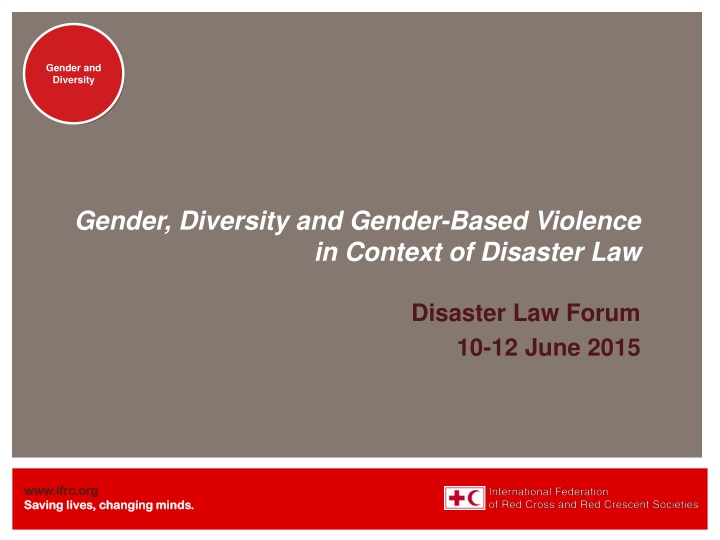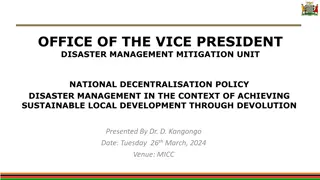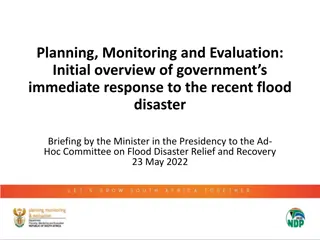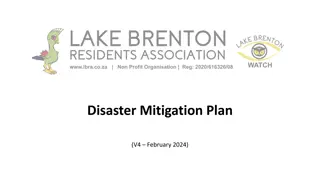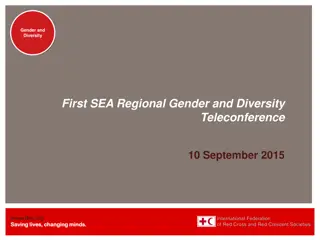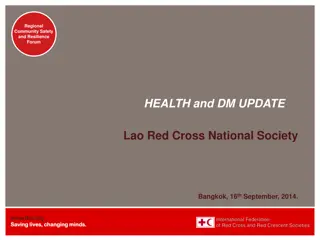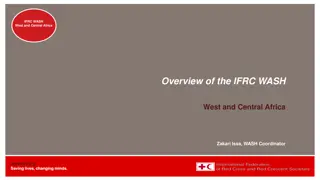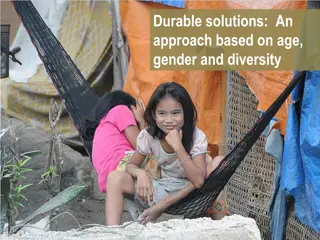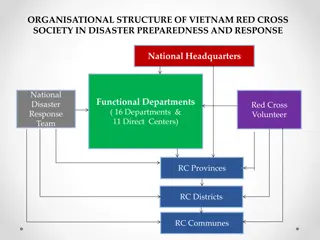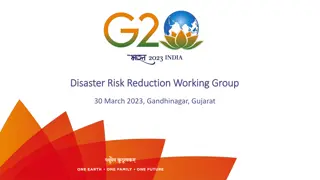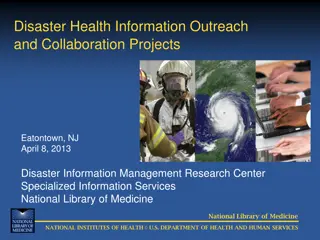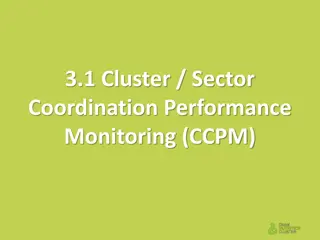Gender, Diversity, and Disaster Law Forum - IFRC Approach
This content discusses the IFRC approach to Gender and Diversity Sensitivity in the context of Disaster Law, addressing Gender-Based Violence and vulnerabilities in disasters. It explores the definitions of sex, gender, and diversity, emphasizing the importance of incorporating gender and diversity into programs and services for reduced inequality.
Download Presentation

Please find below an Image/Link to download the presentation.
The content on the website is provided AS IS for your information and personal use only. It may not be sold, licensed, or shared on other websites without obtaining consent from the author.If you encounter any issues during the download, it is possible that the publisher has removed the file from their server.
You are allowed to download the files provided on this website for personal or commercial use, subject to the condition that they are used lawfully. All files are the property of their respective owners.
The content on the website is provided AS IS for your information and personal use only. It may not be sold, licensed, or shared on other websites without obtaining consent from the author.
E N D
Presentation Transcript
Gender and Gender and Diversity Diversity Gender, Diversity and Gender-Based Violence in Context of Disaster Law Disaster Law Forum 10-12 June 2015 www.ifrc.org www.ifrc.org Saving lives, changing minds. Saving lives, changing minds.
Session objectives Gender and Diversity To provide information about the IFRC approach to Gender and Diversity Sensitivity as an analytical framework for Disaster Law To define Gender Based Violence in the context of Disaster Law, demonstrating the linkage of Disaster Law development to national laws and policies on reducing Gender Based Violence To provide information about recent mapping and research into Gender Based Violence in disasters in the context of Disaster Law and Gender Based Violence at the International Conference 2015 www.ifrc.org www.ifrc.org Saving lives, changing minds. Saving lives, changing minds.
Sex and Gender Gender and Diversity Sex: refers to the biological differences between men and women Gender: refers to the social differences between men and women all those who are vulnerable to inequality, harm and loss of basic rights because of their gender. www.ifrc.org www.ifrc.org Saving lives, changing minds. Saving lives, changing minds.
Diversity Gender and Diversity Diversity: refers to the acceptance and respect of differences between people. Physical or Social: sexual orientation, age, disability, HIV status, socio-economic status, religion, nationality and ethnic origin www.ifrc.org www.ifrc.org Saving lives, changing minds. Saving lives, changing minds.
IFRC Strategic Framework on Gender and Diversity issues Gender and Diversity Systematic incorporation of gender and diversity in programs, services and tools 1 Improved gender and diversity composition 2 Active promotion of fundamental principles to ensure reduced gender and diversity- based inequality 3 www.ifrc.org www.ifrc.org Saving lives, changing minds. Saving lives, changing minds.
Vulnerabilities of gender and diversity in disasters Gender and Diversity Women, girls and boys are 14 times more likely to die during a disaster than are men Asia Tsunami, 2004 +70% fatalities women Japan earthquake /tsunami, 2011 65% of casualties were 60+ www.ifrc.org www.ifrc.org Saving lives, changing minds. Saving lives, changing minds.
Gender and diversity considerations Gender and Diversity Importation of necessary and appropriate relief items Use of adequately trained personnel Ensure full and equal consultation with beneficiaries Ensure early warning systems are gender and diversity sensitive www.ifrc.org www.ifrc.org Saving lives, changing minds. Saving lives, changing minds.
Gender and Diversity Diversity Gender and Sexual and Gender Based Violence as a priority in Disaster Response and Law www.ifrc.org www.ifrc.org Saving lives, changing minds. Saving lives, changing minds.
Defining Sexual and Gender Based Violence Gender and Diversity (Sexual and) Gender-based violence (SGBV) is an umbrella term for any harmful act that results in, or is likely to result in, physical, sexual or psychological harm or suffering to a woman, man, girl or boy on the basis of their gender. Sexual and GBV is a result of gender inequality and abuse of power. Includes and is not limited to: sexual violence domestic violence, trafficking for sexual exploitation or domestic slavery, harmful traditional practices; forced or early marriage, forced prostitution; sexual harassment gender-based discrimination (e.g. denial of service access) www.ifrc.org www.ifrc.org Saving lives, changing minds. Saving lives, changing minds.
What we already know about SGBV Gender and Diversity Exists in all societies in which we work Crosses class and educational divides Is often already a Government policy priority prior to disasters Crosses ministerial, departmental and policy areas Correlation to gender inequality This bar chart shows the correlation between government initiatives to address gender equality, and levels of GBV. www.ifrc.org www.ifrc.org Saving lives, changing minds. Saving lives, changing minds.
International and Regional commitments Gender and Diversity ASEAN Declaration on Elimination of Violence Against Women Sendai Framework for Disaster risk reduction 2015 2030 Reducing Vulnerability and Social Inclusion ASEAN ASCC on issues of social inclusion and protection www.ifrc.org www.ifrc.org Saving lives, changing minds. Saving lives, changing minds.
Country Policy Ministry/Supporting committee Some examples Prevention of violence against women 204-2018 (NAPVAW) Law on Suppression of Human Trafficking and Sexual Exploitation 2007 Cambodia 2nd National Action Plan on Ministry for Women's Affairs Ministry of Health Government Technical Working Group on Gender and Gender Based Violence Gender and Diversity Philippines Republic Act No. 9262 (Anti-Violence Against Women and Their Children Act of 2004) Inter-Agency Council on Violence Against Women and Their Children Department of Social Welfare and Development Department of the Interior and Local Government Thailand Protection of Victims of Domestic Violence Act, 2007; Anti-trafficking in Persons Act 2008 Numerous jurisdictions Health Ministry - One Stop Crisis Centre Timor-Leste Law 7/2010 on Domestic Violence With support Judicial System Monitoring Program Law on Domestic violence prevention and control 2007; and Law of Marriage and the Family 2000 Viet Nam Committee on Ethnic Minority Affairs (Vietnam) Ministry of Health (Vietnam) National Committee for the Advancement of Women in Vietnam Law on Elimination of Domestic Violence (2004); Plan of action for research into all forms of GBV in Indonesia Indonesia Ministry of Women's Empowerment - Strategic Plan to eliminate GBV www.ifrc.org www.ifrc.org Saving lives, changing minds. Saving lives, changing minds.
Exacerbating factors in emergencies Gender and Diversity (Sometimes) decreased family cohesion Interrupted social protection mechanisms (Total) breakdown in health, justice and regular social services Access to justice, to remedy and to safety decreases Inappropriate assistance (not based on consultation with community) Increased number of actors Increased chaos and opportunities for GBV Increased levels of separation Hyper gender roles the division of labour is often intensified (women care for children, take care of reproductive roles) Increased use of negative coping strategies on behalf of men, women, boys and girls www.ifrc.org www.ifrc.org Saving lives, changing minds. Saving lives, changing minds.
Examples from recent emergencies Gender and Diversity New Zealand Earthquake Domestic violence referrals increase by 400% 2004 Tsunami recue workers prosecuted for rape in Sri Lanka 2005 floods in Pakistan early and forced marriage increases in face of increased poverty and desperation 2010 Haiti earthquake sexual exploitation and abuse of children on mass scale 2013 Typhoon Yolanda Prevention of violence activities to safeguard gains in the field of GBV prevention and response www.ifrc.org www.ifrc.org Saving lives, changing minds. Saving lives, changing minds.
Movement wide mapping and research Gender and Diversity 2014-2015 Mapping exercise: 54 National Societies and ICRC have responded. 14 NSs in Asia Pacific identify GBV programming as priority. Research in 10 countries on SGBV in Disasters: Samoa Australia Bangladesh Myanmar Bosnia and Herzegovina Malawi Namibia El Salvador Haiti Europe TBC www.ifrc.org www.ifrc.org Saving lives, changing minds. Saving lives, changing minds.
Next steps Gender and Diversity Research partnership, and continued programming International conference Strengthened action www.ifrc.org www.ifrc.org Saving lives, changing minds. Saving lives, changing minds.
Disaster Law and Policy Considerations Gender and Diversity For Governments Apply a Gender Lens in any review of Disaster Laws Identify existing SGBV policies at national and regional level, ensuring they are implemented in emergencies Monitor and address SGBV as a disaster response priority Strengthen evidence through research and advocacy on how to effectively mitigate SGBV in disasters Endorsement of the International Conference Resolution on SGBV in Disasters www.ifrc.org www.ifrc.org Saving lives, changing minds. Saving lives, changing minds.
Gender and Diversity ASEAN ASEAN Committees to work together to ensure that gender and diversity commitments are upheld in times of disaster and integrated as a strategic priority across committees and frameworks National Societies Disseminate research findings and mapping findings Continue gender and diversity sensitive DRR programming Act on the basis that SGBV exists and requires a response in emergencies ( Area of responsibility ) Provide technical support on gender and diversity sensitive disaster management www.ifrc.org www.ifrc.org Saving lives, changing minds. Saving lives, changing minds.
FOR FURTHER INFORMATION ON GENDER, PLEASE CONTACT: IFRC GENDER AND DIVERSITY ADVISOR, ASIA PACIFIC ZONE MAY MALONEY (may.maloney@ifrc.org) IFRC GENDER AND DIVERSITY ADVISOR, SOUTH EAST ASIA REGIONAL DELEGATION CHRISTINAHANEEF (christina.haneef@ifrc.org) THIS PRESENTATION IS PUBLISHED BY INTERNATIONAL FEDERATION OF RED CROSS AND RED CRESCENT SOCIETIES P.O. BOX 372 CH-1211 GENEVA 19 SWITZERLAND TEL.: +41 22 730 42 22 FAX.: +41 22 733 03 95
